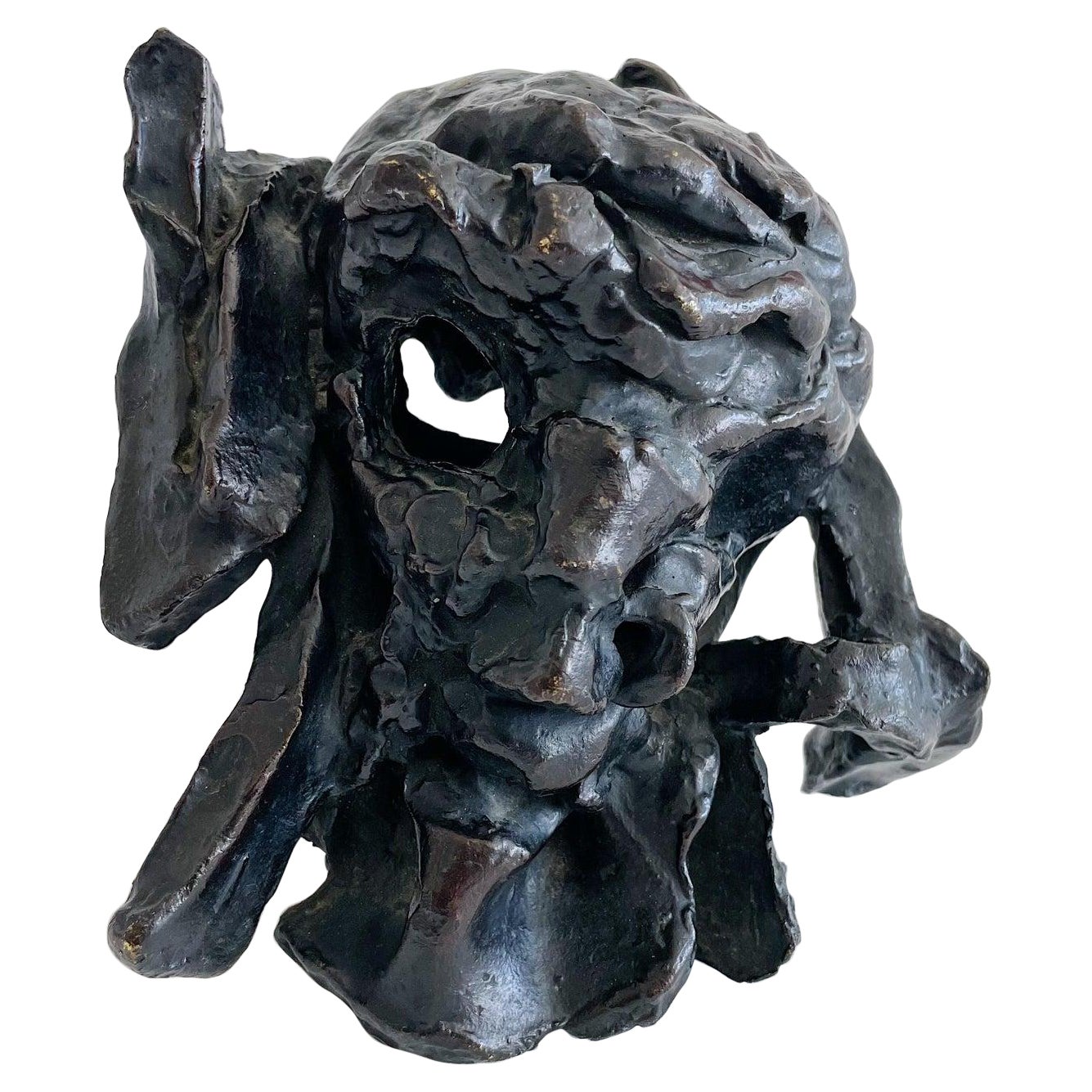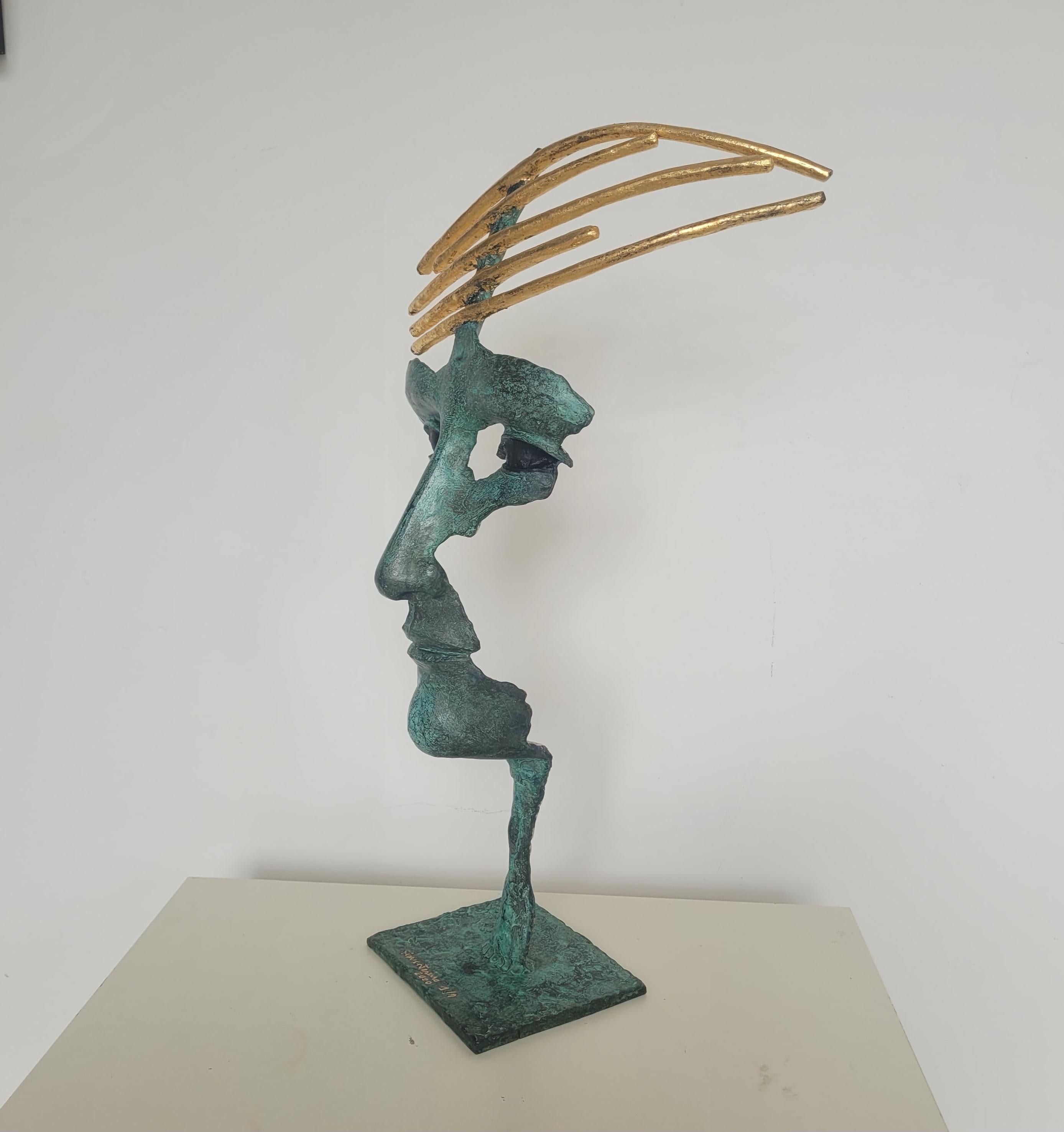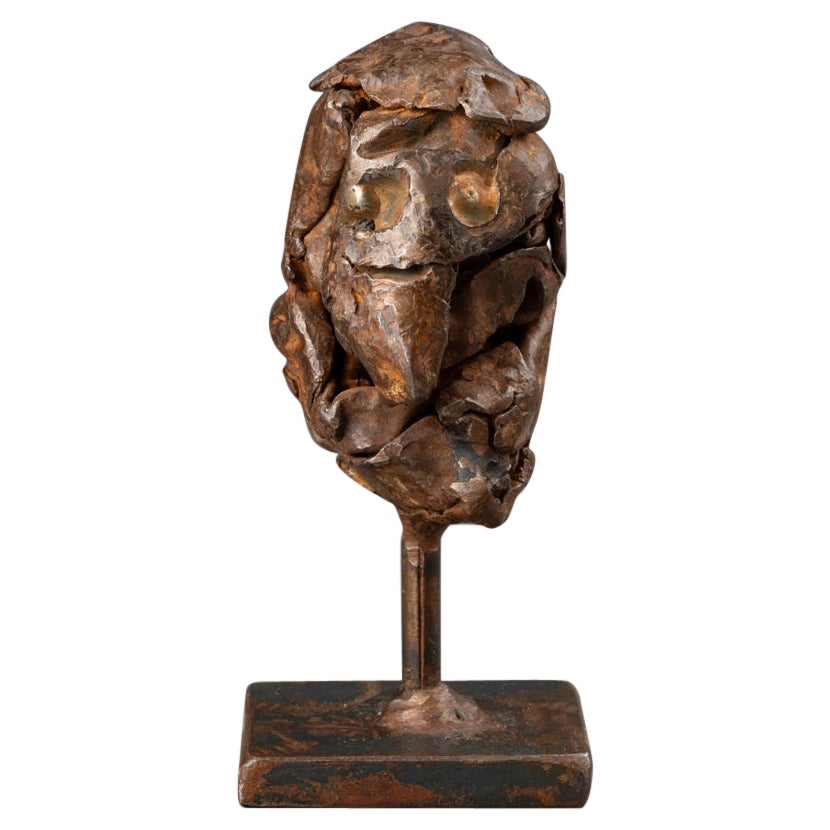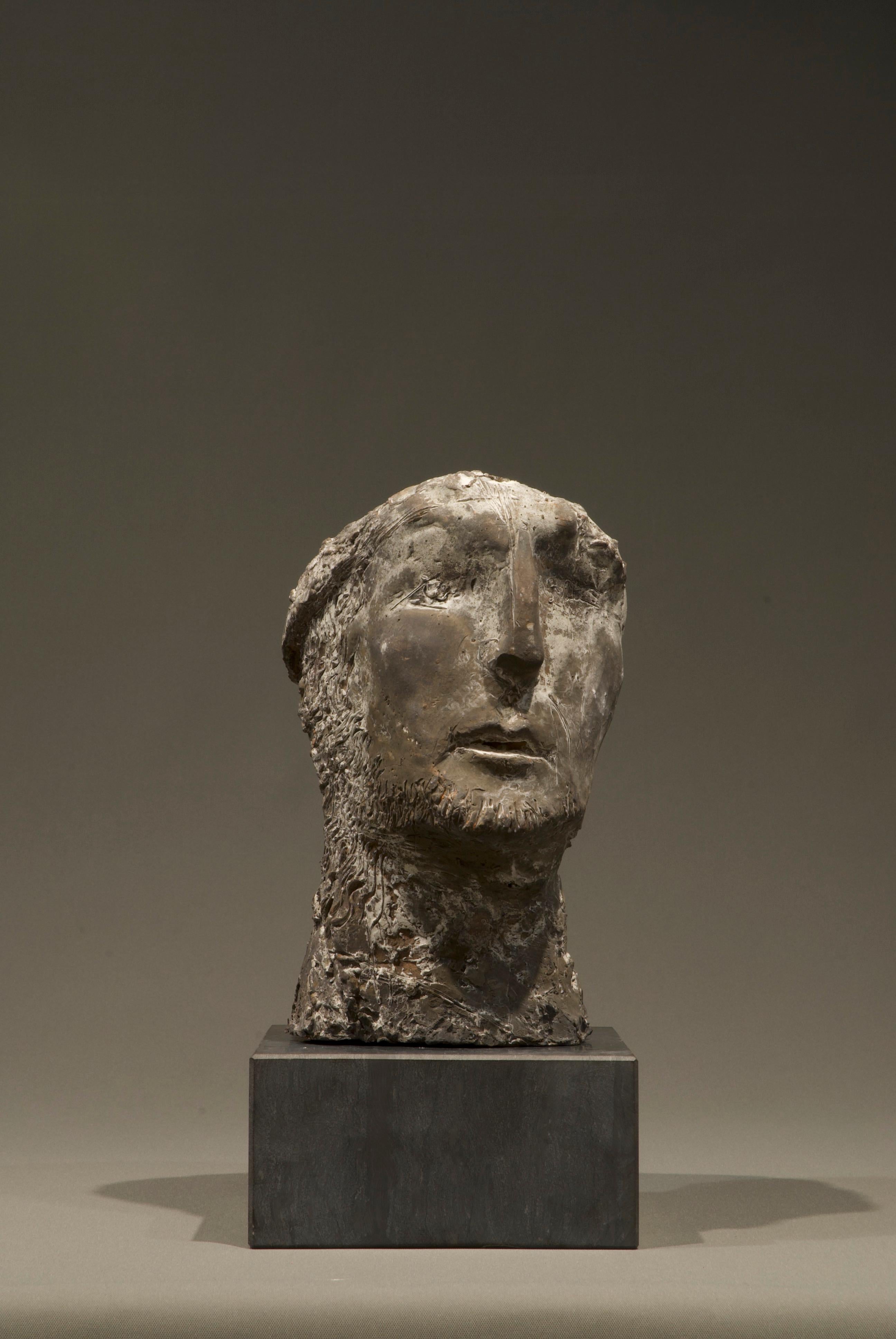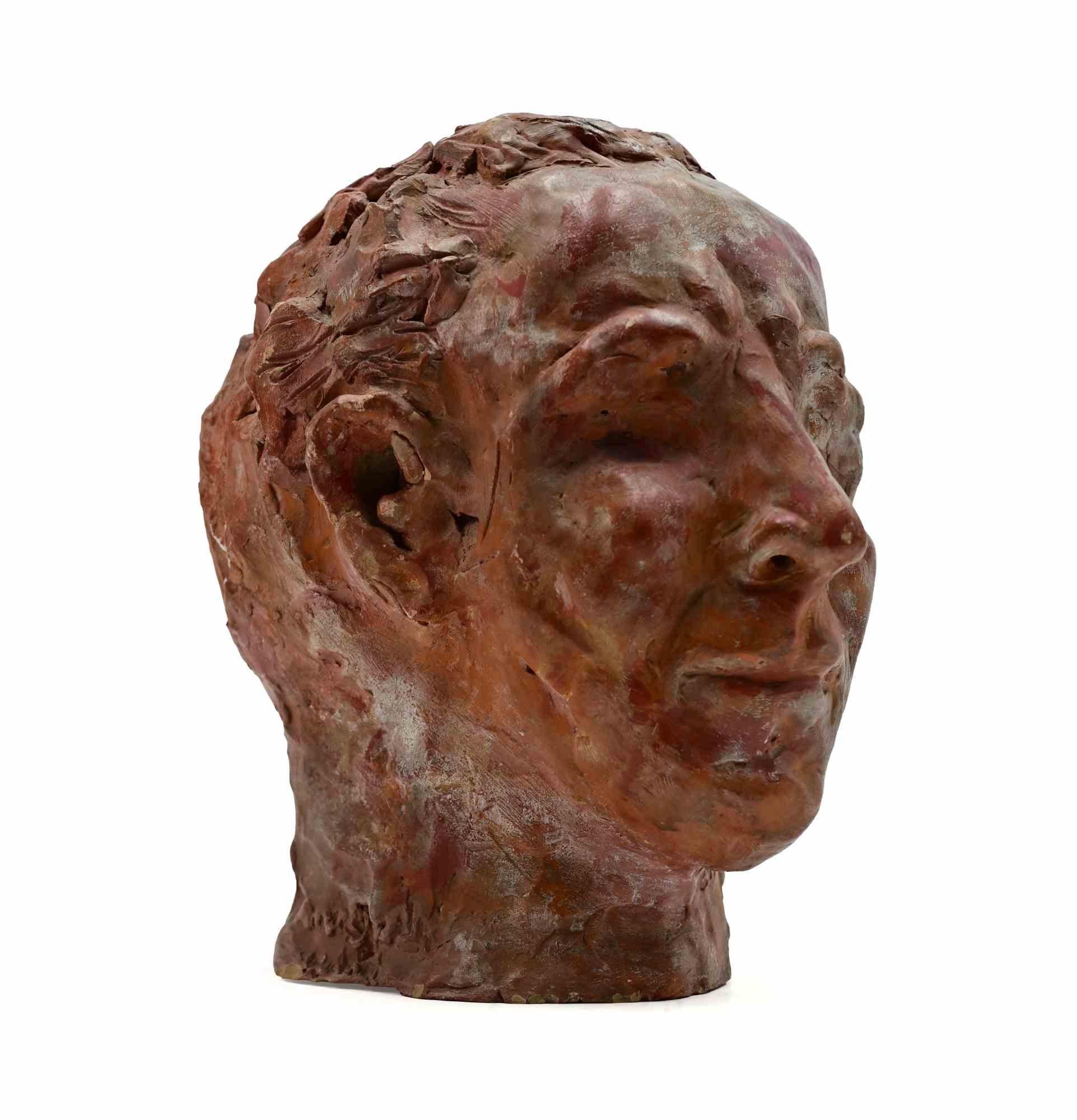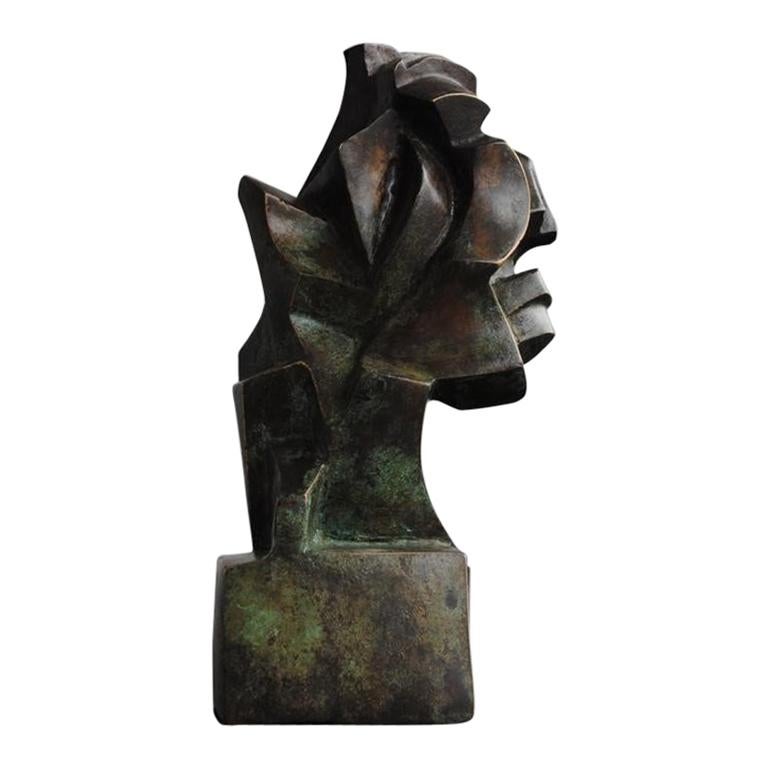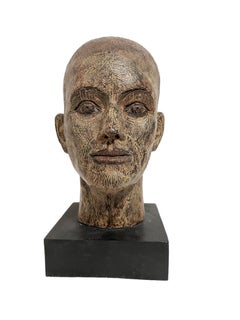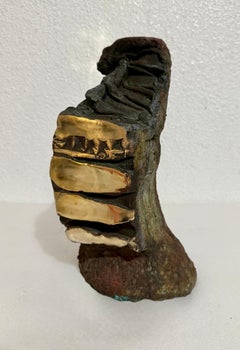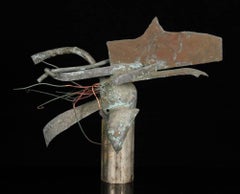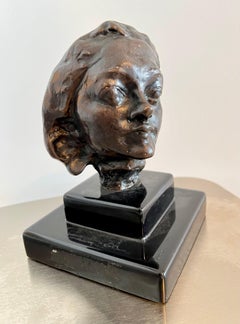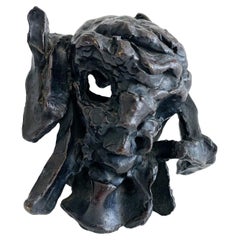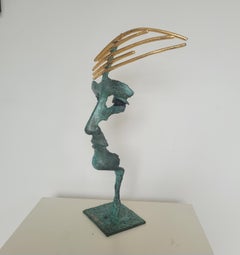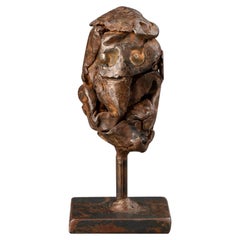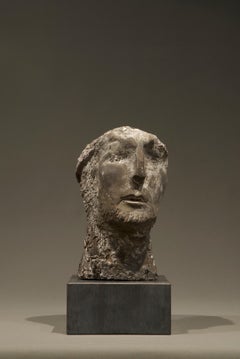Items Similar to Untitled, Head Of An Artist, Avant-Garde Bronze Sculpture
Want more images or videos?
Request additional images or videos from the seller
1 of 7
Phillip PaviaUntitled, Head Of An Artist, Avant-Garde Bronze Sculpture1982
1982
$10,000
£7,599.33
€8,746.25
CA$14,310.51
A$15,723.15
CHF 8,108.33
MX$188,379.22
NOK 102,950.79
SEK 96,615.13
DKK 65,322.20
About the Item
This is a bronze cast sculpture by Philip Pavia is part of his series of "Imaginary Portraits from the Club" , a one-man exhibition at Max Protetch Gallery, New York in 1982. The approach at rendering the figure is grotesque, and the facial features have been severely distorted to the point were the portrait becomes an abstract interpretation of the subject.
As an artist and writer, Philip Pavia was a committed member of the Abstract Art community throughout his long, distinguished career. Pavia was active in the art world until his death in 2005 and received immense critical praise for his artistic and literary contributions. Recognized for his signature work The Ides of March, he produced monumental pieces that alternated between figurative and abstract styles. While he was a dedicated sculptor, Pavia extended that passion into writing and published It is: A Magazine for Abstract Art.
Born in 1911 of Provencal-Italian descent, the Stratford, Connecticut native received early inspiration from his father, a professional stone cutter. Pavia's sculptures are characterized by rough, chiseled bronze and marble, his father's trade was no doubt a significant influence. In fact, by 1934, his father was so enthusiastic about his son's passion that he encouraged young Philip to study at the Academia delle Belle Arti in Florence, Italy.
Before his studies in Europe, Pavia was briefly a student at Yale University but quickly dropped out and enrolled at New York's Art Student League. While attending school, he befriended artists Jackson Pollock and Arshile Gorky. All three were to become major players of the vibrant new Abstract Art movement. At his father's advice, Pavia embarked on his European experience and was introduced to other influential artists of his time. Traveling between Italy and Paris, Pavia met John Ferren, John Graham, Landes Lewitin, and writer Henry Miller.
In the 1940s, Pavia's career started to take form and he became a founding member of the art and intellectual group, The Club. Amongst the group's membership were legendary artists and thinkers including Willem and Elaine de Kooning, Franz Kline, John Cage, Robert Motherwell, Joseph Campbell, Barnett Newman, Hannah Arendt, and Leo Castelli. The group organized discussions that proved critical for the expansion of Abstract Art. The experience would inspire Pavia’s later writings. While flourishing as a facilitator of art theory, Pavia also showcased his sculpture in the 1946 exhibit "Five Americans: Sculpture Heads."
Well into the 1950s, Philip Pavia ended his work with The Club and, in 1956, founded the magazine It is: A Magazine for Abstract Art. In the publication, he reinforced his devotion to abstract art and expressed a dissenting opinion about surrealism and other art styles that favored a dreamy, fantasy-like direction. During this time of literary progress, he participated in a series of shows which included the Stable Gallery's annual exhibition and two self-titled shows at the Great Jones and Samuel Kootz galleries in New York. Pavia also made a television appearance in the feature Twelve Sculptors for NBC.
Pavia's art success continued into the 1960s with a group exhibition at New York's Museum of Modern Art. He was also featured in the BBC television program Twentieth Century American Sculptors in 1963. Pavia participated in another group show at New York's Green Gallery and returned to his native Connecticut for the show "Continuity and Change: Old and New Work by Contemporary Artists." There wasn't any shortage of coverage for Pavia as he landed more solo exhibitions at the Guggenheim Museum, San Francisco Museum of Art, and The Gallery of Modern Art in Washington, D.C.
However, his staggering success in the 1960s is not complete without the production of the renowned work The Ides of March. Crafted in 1963, this piece was commissioned by the New York Hilton to grace the entrance of their hotel. Comprising of four rhombus-shaped sculptures ranging in size of 6ft to 10ft, The Ides of March glistens with the natural bronze hues of moss green and rusted orange. The epic piece features Pavia’s signature rough, chiseled texture and abstract style. The masterpiece stood tall at the Hilton until it was eventually moved to the Hippodrome building in 1988.
Throughout his long career, Pavia crafted a range of different works that included abstracted heads in bronze, marble, and painted terracotta. He continued to produce more abstract works that favored simplistic yet heavily textured shapes, and sculptures were chiseled to look unrefined and mimic the action of pieces breaking in the process. The work never detoured from the realms of abstract and figurative, proving his devotion to the movement he helped shape.
His career momentum continued through the 1970s with the unveiling of his John F. Kennedy portrait at the Metropolitan Museum of Art. The unconventional portrait sculpture was crafted as a 6-foot bronze abstracted head. Pavia produced more large-scale works which included the colossal 10-foot tall marble piece Wind, Sand and Stars. More one-man exhibitions and group shows followed in the 1980s, and his signature bronze heads appeared in their own exhibition, Five Bronze Heads, for a show in Washington, D.C. By the late 1980s and early 1990s, he produced a great deal of marble works featured at New York's Thorp Gallery, Italy's Il Salotto Galleria, and the Guild Hall Museum.
Toward the end of his career, Philip Pavia continued to produce and exhibit works which showcased that lifelong devotion to the craft. Starting in 1995, he garnered a stream of accolades that included an honorary doctorate from the Pennsylvania Academy of Painting and Sculpture, becoming a 2002 Artists Equity honoree, receiving the prestigious Pollock-Krasner grant, and winning the Guggenheim Award for Sculpture. Two years before his death, Pavia exhibited his final collection of new works entitled "latest decade, black and white sculptures and related water colors."
Pavia remained active in the art world up until his death in 2005. However, an artist's life is never complete without a little controversy. One month before his death, a suspected art heist took place which involved his seminal work, The Ides of March. In preparation for its move to Hofstra University, the sculpture was packed up at a storage facility near its home at the Hippodrome. However, while waiting for the big move, three of the four pieces mysteriously went missing. A devastation for Pavia and the art community, people feared the pieces would never be recovered. However, as luck should have it, the pieces were found by a scrap metal dealer in the Bronx, and the work become whole once again before Philip Pavia passed.
- Creator:Phillip Pavia (1912-2005, American)
- Creation Year:1982
- Dimensions:Height: 11.5 in (29.21 cm)Width: 8.5 in (21.59 cm)Depth: 7 in (17.78 cm)
- Medium:
- Movement & Style:
- Period:
- Condition:
- Gallery Location:Surfside, FL
- Reference Number:1stDibs: LU38212217932
About the Seller
4.9
Platinum Seller
Premium sellers with a 4.7+ rating and 24-hour response times
Established in 1995
1stDibs seller since 2014
1,818 sales on 1stDibs
Typical response time: 1 hour
- ShippingRetrieving quote...Shipping from: Surfside, FL
- Return Policy
Authenticity Guarantee
In the unlikely event there’s an issue with an item’s authenticity, contact us within 1 year for a full refund. DetailsMoney-Back Guarantee
If your item is not as described, is damaged in transit, or does not arrive, contact us within 7 days for a full refund. Details24-Hour Cancellation
You have a 24-hour grace period in which to reconsider your purchase, with no questions asked.Vetted Professional Sellers
Our world-class sellers must adhere to strict standards for service and quality, maintaining the integrity of our listings.Price-Match Guarantee
If you find that a seller listed the same item for a lower price elsewhere, we’ll match it.Trusted Global Delivery
Our best-in-class carrier network provides specialized shipping options worldwide, including custom delivery.More From This Seller
View AllRare Cast Painted Bronze Head Sculpture British Realist Sculptor John Davies
Located in Surfside, FL
John Davies (Cheshire, 1946), British sculptor.
Bronze sculpture head
Unique cast (1/1)
This was shown at Marlborough Fine Art (London) Ltd in a show called John Davies New Sculpt...
Category
1990s Figurative Sculptures
Materials
Bronze
Enrico Donati Abstract Expressionist Brutalist Bronze Sculpture Surrealist Art
By Enrico Donati
Located in Surfside, FL
Enrico Donati (1909 – 2008)
A Brutalist Bronze Surrealist Sculpture Totem.
With a great patina and both rough and high polished textured bronze.
Signed on side
Dimensions: height ...
Category
20th Century Surrealist Abstract Sculptures
Materials
Bronze
Brutalist Bronze Abstract Modernist Sculpture
Located in Surfside, FL
In the manner of Julio Gonzalez, mixed metal sculpture.
Neo-Dada Abstract Sculpture: Assemblages
Abstract sculpture followed a slightly different course. Rather than focusing on no...
Category
20th Century Abstract Expressionist Abstract Sculptures
Materials
Bronze, Copper
Small Bronze Sculpture Cast Head After Rodin "Petite tete au nez retrousse"
By Auguste Rodin
Located in Surfside, FL
(after) Auguste Rodin
Posthumous cast
"Petite tete au nez retroussé"
Featuring a bust of a woman.
Limited edition bronze is mounted on a marble base and is signed on the lower right. Great detail.
Dimensions: approx. 7-1/4" tall x 5" across x 5" deep with base
Foundry mark on the reverse, #13 of 299 produced.
François Auguste René Rodin (1840 – 1917) was a French sculptor generally considered the founder of modern sculpture. Rodin possessed a unique ability to model a complex, turbulent, and deeply pocketed surface in clay. He is known for such sculptures as The Thinker, Monument to Balzac, The Kiss, The Burghers of Calais, and The Gates of Hell. He modeled the human body with naturalism, and his sculptures celebrate individual character and physicality. Although Rodin was sensitive to the controversy surrounding his work, he refused to change his style, and his continued output brought increasing favor from the government and the artistic community.
Rodin became the preeminent French sculptor of his time. By 1900, he was a world-renowned artist. Wealthy private clients sought Rodin's work after his World's Fair exhibit, and he kept company with a variety of high-profile intellectuals and artists. His student, Camille Claudel, became his associate, lover, and creative rival. Rodin's other students included Antoine Bourdelle, Constantin Brancusi, and Charles Despiau.
Rodin entered the studio of Albert-Ernest Carrier-Belleuse, a successful mass producer of objets d'art. Rodin worked as Carrier-Belleuse' chief assistant until 1870, designing roof decorations and staircase and doorway embellishments. With the arrival of the Franco-Prussian War, Rodin was called to serve in the French National Guard, but his service was brief due to his near-sightedness. Rodin took classes with animal sculptor Antoine-Louis Barye. The teacher's attention to detail and his finely rendered musculature of animals in motion significantly influenced Rodin. Rodin won the 1880 commission to create a portal for a planned museum of decorative arts. Rodin dedicated much of the next four decades to his elaborate Gates of Hell, an unfinished portal for a museum that was never built. Many of the portal's figures became sculptures in themselves, including Rodin's most famous, The Thinker and The Kiss. With the museum commission came a free studio, granting Rodin a new level of artistic freedom.
By 1900, Rodin's artistic reputation was established. Gaining exposure from a pavilion of his artwork set up near the 1900 World's Fair (Exposition Universelle) in Paris, he received requests to make busts of prominent people internationally, As Rodin's fame grew, he attracted many followers, including the German poet Rainer Maria Rilke, and authors Octave Mirbeau, Joris-Karl Huysmans, and Oscar Wilde.
Rodin and Beuret's modest country estate in Meudon, purchased in 1897, was a host to such guests as King Edward, dancer Isadora Duncan, and harpsichordist Wanda Landowska. He left Beuret in Meudon and began an affair with the American-born Duchesse de Choiseul. From 1910, he mentored the Russian sculptor, Moissey Kogan...
Category
20th Century Modern Figurative Sculptures
Materials
Bronze
Latin American Art Figurative Abstract Bronze Sculpture Lovers Marcelo Morandin
Located in Surfside, FL
Marcelo Morandin 1933-1996
Untitled (Embracing Couple, Lovers)
Bronze 1988; ed. P/E; Hand signed, dated and editioned to lower edge DImensions: 48.5 x 32 x 21 cm / 18.8 x 12.5 x 8.2 inches (approximately)
PAREJA, Bronce, patinado
Marcelo Morandin (1933 - 1996) was active/lived in Argentina, Mexico.
Argentinian, Mexican Postwar & Contemporary sculptor Morandin is best known for his monumental sculpture. This is a wonderful, art deco inspired nude couple, the woman appears pregnant).
Marcello Morandín (Marcelo Román Morandín Paroni) was born in 1933 in Argentina. He was an important plastic artist and Argentine architect, distinguished in Mexico for being an excellent sculptor and furniture designer. At the end of his studies at the Faculty of Architecture of Buenos Aires, Argentina, he traveled to Mexico and settled in Xalapa, Veracruz. In this city he was part of several artistic projects and noted for being one of the founders of the Department of Aesthetic Research and Applied Design at the University of Veracruz, as well as the Department of Aesthetic Research at UNAM. Between the years 80 and 90, he carried out several monumental works, among them "La pigeon de la paz" a project for the UN; "The foundation of Tenochtitlan" located in front of the Official Residence of Los Pinos; and "The Kinetic Tower" Of the government of Veracruz that combines the light and the sound with diverse moving parts to the compass of the music of Arnold Schoenberg. (Lily Kassner. Dictionary of Mexican sculptors of the twentieth century. Volume II. Mexico. Conaculta, 1997). Similar in style to Israeli artists Aharon Bezalel and Isaac Kahn.
He has shown with Jose Villalobos, Nicolas Moreno, Pedro...
Category
1980s Abstract Sculptures
Materials
Bronze
Large Latin American Modernist Bronze Abstract Cuban Master Roberto Estopinan
By Roberto Estopiñan
Located in Surfside, FL
Roberto Estopinan, Cuban, 1920 - 2015
Dimensions: 24.5" wide x 13" high plus 6" high base.
Roberto Estopiñán (1921–2015) was a Cuban American sculptor known for his sculptures of the human form, including political prisoners. Born in Camaguey, Cuba, he lived in the United States for over fifty years. His works are held by major institutions such as the Museum of Modern Art, the Whitney Museum and the Smithsonian Museum of American Art.
Roberto Gabriel Estopinan, a sculptor, draftsman, and printmaker, was born in Havana, Cuba on March 18, 1921. Estopiñán enrolled at the San Alejandro Academy when he was just 14 years old and became the protegé and studio assistant of the sculptor Juan José Sicre. After graduation he traveled first to Mexico, where he met and befriended Francisco Zuniga, and studied Pre-Columbian sculpture. In 1949 he traveled to Europe, visiting England, France and Italy. In these trips he encountered the sculpture of Henry Moore and Marino Marini, and their humanistic yet formal visions would be influential on Estopinan's work. Estopiñán was a pioneer of direct carvings using wood and of welding techniques in Latin America. Throughout the 1950s, Estopiñán received important prizes at various national exhibitions in Havana. In 1953 he was the only semi-finalist from Latin America at the Tate Gallery's international sculpture competition for a Monument to the Unknown Political Prisoner. In 1961, the artist moved to New York, where he resided until 2002.
Roberto Gabriel Estopiñán a Cuban emigre sculptor who emigrated to exile in the United States not long after Fidel Castro’s revolution in 1959, is considered one of Latin America’s most important 20th-century artists. His work, which includes drawings and prints as well as sculptures in wood and bronze, is in the collections of New York’s Museum of Modern Art, the Smithsonian’s American Art Museum, the Art Institute of Chicago, and the Detroit Institute of Art, among many locations. He is best known for his stark, disturbing renderings of political prisoners, the fruit of his own experiences as a dissident under both Castro and his predecessor, the dictator Fulgencio Batista, and for his representations of the female torso that can remind viewers of both classical statuary and the high-modern, abstractly elongated work of Henry Moore.mHe was born in Havana to a father from Asturias in northwest Spain and a mother of African descent. Estopiñán was something of a prodigy. At the age of fourteen, he won the first prize in drawing at the Centro Asturiano, a regional association for Cubans of Asturian descent. Shortly afterward he received special permission to enter the San Alejandro Academy of Fine Arts in Havana. At the school he was mentored first by its director, the painter Armando Menocal (1863-1941), then by the landscape artist Antonio Rodríguez Morey (1872-1967), and finally by Juan José Sicre (1898-1974), regarded as one of Cuba’s greatest sculptors. Sicre, a professor of sculpture at the Academy, had helped introduce European modernist art to Cuba, and from the 1930s through the 1950s had sculpted monumental figures in Havana of José Martí and other Cuban national heroes that stand to this day. Estopiñán was first Sicre’s student, then his assistant, and, finally, his colleague for the next fifty years. After graduating from San Alejandro in 1942, Estopiñán began simultaneously teaching art at the Ceiba del Agua School for young men, assisting Sicre in public art projects and developing his own artistic vision. He also traveled widely, to Mexico, New York, France, and Italy. From the late 1940s through the 1950s his sculpture evolved from an early neoclassical phase under the influence of Maillol to what he defined as “formalist humanism”: emphasizing the abstract beauty of the shapes he sculpted while not abandoning the human figure as the basis of his work. As the 1950s progressed he chose to carve in native Cuban woods...
Category
20th Century Abstract Figurative Sculptures
Materials
Bronze
You May Also Like
Mid Century Abstract Face Bronze Sculpture by Jean Robert Ipousteguy
By Jean-Robert Ipoustéguy
Located in West Palm Beach, FL
Bronze abstract face sculpture by Jean-Robert Ipoustéguy (January 6, 1920 – February 8, 2006, a figurative French sculptor.. Signed on back underside Ipoustegy '66 2/9.
I'm many museum and public art collections such as:
Abu Dhabi, National Museum of Saadiyat Island.
Baltimore, Baltimore Museum of Art.
Berlin, Nationalgalerie.
Bobigny, Fonds Départemental d’Art Contemporain.
Cambridge, Massachusetts, US (Massachusetts Institute of Technology, MIT) — Cénotaphe (1957)[8]
Châlons en Champagne, Musée des Beaux-Arts et d'Archéologie.
Chicago, Art Institute.
Copenhagen, Carlsberg Glyptotek.
Darmstadt, Hessiches Landesmuseum.
Dun sur Meuse, Centre Ipoustéguy
Evanston, Illinois, Mary and Leigh...
Category
Vintage 1960s French Mid-Century Modern Abstract Sculptures
Materials
Bronze
Composer's head. Contemporary bronze sculpture, Limited edition, Italian artist
By Antonio Giancaterino
Located in Warsaw, PL
Contemporary figurative with abstract element patinated bronze sculpture pture by Italian artist Antonio Giancaterino. Sculpture is an artistic portrait that looks more or less abstr...
Category
2010s Other Art Style Figurative Sculptures
Materials
Bronze
"Abstract head": Signed sculpture in bronze and patinated metal - 20th C.
Located in SAINT-OUEN-SUR-SEINE, FR
"Abstract Head": Bronze and patinated metal sculpture representing a head treated in an abstract style
Bearing a signature under the bronze base
Dimensions
Height = 12 cm
Widt...
Category
Vintage 1970s French Brutalist Abstract Sculptures
Materials
Brass, Bronze
Der Seher II Bronze Sculpture Portrait Abstract Art
By Thomas Junghans
Located in Utrecht, NL
Der Seher II Bronze Sculpture Portrait Abstract Art
Junghans (1956, Recklinghausen) creates abstract sculptures in stone, wood and bronze, ...
Category
21st Century and Contemporary Contemporary Abstract Sculptures
Materials
Bronze
Portrait - Sculpture by Sirio Pellegrini - 1960s
Located in Roma, IT
Painted Terracotta sculture realized by Sirio Pellegrini in 1960s.
Good condition.
Sirio Pellegrini, born in Rome on March 1, 1922, of Abruzzo origins (Capestrano), spent his child...
Category
1960s Modern Figurative Sculptures
Materials
Terracotta
Contemporary Cubist Head in Bronze by Perrine Le Bars
By Perrine Le Bars
Located in Marseille, FR
Cubist bronze sculpture by Perrine Le Bars. Cast by "Fa Boniface Bassan côte d'ivoire".
Category
20th Century French Abstract Sculptures
Materials
Bronze
More Ways To Browse
Sculpture Head
Bronze Head
Figurative Sculpture Head
Bronze Head Sculptures
Used Scrap Metal
Abstract Head Sculpture
Sculpture 6ft
Phillips Bronze Sculpture
Indoor Tree Sculpture
Jacqueline Picasso Ceramic
Jiang Tie Feng Sculpture
Jimmie Martin
Joseph Ndandarika
Julie Jaler
Kaws Resting
Klein Blue Sculpture
Kurt Weiser
Leonard Baskin Bronze Sculpture
